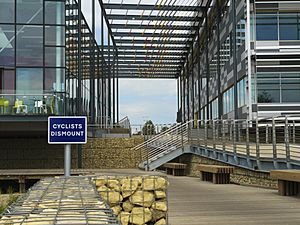West Cambridge facts for kids
West Cambridge is a special area in Cambridge, England. It is a big site for the University of Cambridge. Many university departments have moved here. They moved from the busy city centre because they needed more space. Other research groups also have buildings here.
Contents
Exploring West Cambridge
The West Cambridge site is a large area. It sits between the M11 motorway, Madingley Road, Clerk Maxwell Road, and the Coton Footpath. You can find open fields and a small lake here. Besides university departments, there are also private research places. The site also has homes and a restaurant. The roads are named after famous scientists from Cambridge. The Institute of Astronomy is just north of the site. The Centre for Mathematical Sciences is to the east.
Buildings at West Cambridge
Many important buildings are located at West Cambridge. These buildings house different university departments. They also host research centres. Here is a list of some of the main buildings and when they were built:
| Name | Built/Completed | What it's for |
|---|---|---|
| Department of Veterinary Medicine | 1955 | Studying and caring for animals |
| Whittle Laboratory | 1973 | Engineering research |
| Cavendish Laboratory | 1974 | Physics research (includes Hitachi Cambridge and Microelectronics Research Centres) |
| British Antarctic Survey | 1976 | Research about the Antarctic |
| Computer-Aided Design Centre | 1978 | Software design |
| Magnetic Resonance Research Centre | 1997 | Chemical Engineering and Biotechnology |
| Chemical Engineering and Biotechnology | 2016 | Chemical Engineering and Biotechnology |
| Schlumberger Cambridge Research Centre | 1984 | Energy technology research |
| William Gates Building | 2001 | Computer science |
| Roger Needham Building | 2001 | University computer services |
| Schofield Centre | 1986/2001 | Engineering - Ground engineering research |
| Nanoscale Science Laboratory | 2003 | Studying tiny materials (nanoscience) |
| Electrical Engineering Division Building | 2006 | Electrical Engineering (includes Centre for Advanced Photonics and Electronics) |
| Centre for the Physics of Medicine | 2008 | Physics and medicine research |
| Alan Reece Building | 2009 | Engineering - Manufacturing research |
| Hauser Forum | 2010 | Supporting new business ideas (entrepreneurship) |
| Department of Materials Science and Metallurgy | 2013 | Studying materials and metals |
| University Sports Centre | 2013 | Sports and physical education |
| West Cambridge Data Centre | 2014 | University computer data storage |
| Physics of Medicine & Maxwell Centre | 2015 | Physics research |
| West Hub | 2022 | General university use |
Future Plans for West Cambridge
New buildings are being planned for the West Cambridge site. A new Cavendish Laboratory (called Cavendish III) is being built. It is expected to be finished by 2021 or 2022. Also, a new Civil Engineering Building (CEB) is planned. It was expected to be ready in spring 2019.
Protecting Nature at West Cambridge
The West Cambridge site is also important for nature. Many native animals live here. You might see barn owls, grey partridges, badgers, and grass snakes. There are also different kinds of amphibians. Experts have been studying the wildlife here since 2003. To help protect these animals and their homes, several ponds are kept clean. Some building roofs are covered with plants like sedum. This helps create more green spaces. They also manage the landscape to keep hedgerows and ditches healthy.
Discovering Ancient History

The West Cambridge site has a rich history hidden underground. An ancient Roman settlement is the most important archaeological find. But there are also signs of older, prehistoric times. And there is evidence of use during the medieval period.
Archaeologists explored the site between 1999 and 2000. They made over 3,000 excavations. They found about 50,000 items! Some of these amazing finds are on display. You can see them in the William Gates Building.
Prehistoric Finds
Archaeologists found Stone Age flints here. They also found pottery pits from the Iron Age. Experts are still studying other possible prehistoric features.
Roman Settlement Discoveries
The site shows a series of Roman fields and enclosures. There were also two timber buildings. They found some quarry pits. Two cemeteries were discovered with forty burials. Five other single burials were also found. This settlement was likely part of a larger Roman system. This system probably surrounded the Roman town. It seems the site was used from the late 1st to early 5th centuries.
Some unusual things were also found. These include a hidden collection of 3rd-century coins. There was also an area with animal bones. These animals were likely used for special ceremonies. Horse and cattle remains marked the entrance of one cemetery. Other finds include spearheads, brooches, and pottery. A copper bust of a god or goddess, possibly Minerva or Pallas Athena, was also found.
Later Uses of the Site
The Roman settlement was left empty around the 5th century AD. Nothing much happened on the site until the late medieval period. That is when people started ploughing the land. A dyke called Willowes Ditch was built. This ditch is shown on maps from the 14th century. No other major changes happened until Vicars Farm was built in the 1800s.



